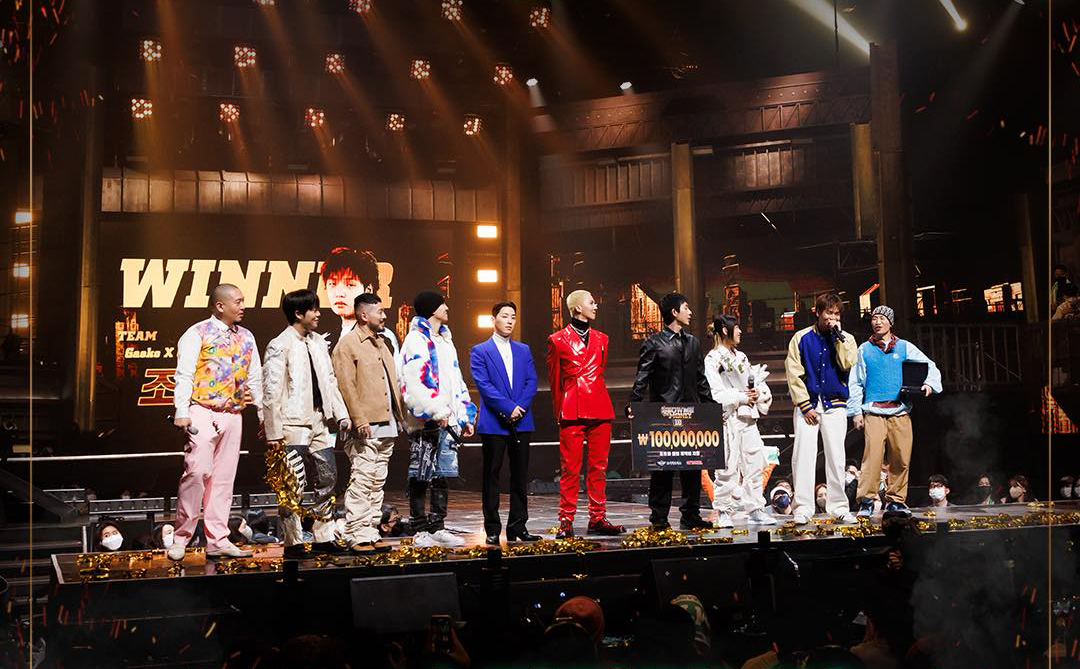
Following last year’s very successful season, Mnet’s Show Me The Money 10 came to an end last week by introducing a new winner, Jo Gwang-il, just one face from yet another strong batch of talents to inject into the industry. For those unfamiliar with it, the show (also known as SMTM) is an annual music competition that filters thousands of rappers down to their elite, pitting them against each other in various rounds to find the best rapper of the crop. Its success varied over the years depending on format changes, editing, contestant talent, and the quality of its songs, but despite poor results in some years, it has continually bounced back to become one of Mnet’s longest-running flagship programmes.
This longevity and popularity mean that, by now, practically every rapper in Korea has been on it either as a judge or a contestant, and it is now almost a rite of passage for budding rappers hoping to get a break. As such, SMTM has established a powerful, symbiotic relationship with the Korean hip hop scene itself, bringing audiences to the genre in return for rappers offering their talent and time. This helped boost both of their mainstream popularity, and following global trends hip hop quickly rose through the 2010s to become the biggest music genre for young people in Korea. This year saw the programme celebrate its tenth season, with over 27, 000 people applying in hopes of becoming the show’s next star.
The show achieved this through a number of valuable strengths that it developed through trial and error over the years. Firstly, as reality TV, it offered high entertainment value by fostering and showcasing a strong sense of community among its participants. At its best, the show was a celebration of their craft, with respected artists assembling as a star-studded judge lineup in order to discover and develop hopeful talents gathering to compete. Contestants eventually joined one of the judges’ teams, and when the rules emphasised teamwork, heartwarming friendships naturally grew. The best examples of these (and by extension the most enjoyable seasons) were SMTM777 and SMTM9 – both fostered genuine friendships among its contestants, and in return, they delivered both excellent TV and performances.
Accordingly, the show was at its worst whenever it became overly trashy, conflict-driven, and melodramatic. An episode where Black Nut broke into a sudden rap verse to diss the judges who had eliminated him comes to mind, as well as his audition where he pulled down his trousers for maximum shock value (what is it with Mnet and people doing that?). Similarly, rules that sacrificed wholesome sportsmanship for dramatic conflict were more unpleasant than entertaining. For example, pairing rappers up only to eliminate one, and having two rappers prepare for a song before only allowing one to perform. The show also occasionally suffered from simply being too boring, usually due to format changes or editing which neglected to showcase contestants’ personalities and skills fully (for example, SMTM8).
Luckily, contestants rarely seemed to suffer from evil editing in the way that Mnet is often known for – perhaps because rappers were often already quite strong characters, who were not afraid of conflict or earning a bad reputation. For them, the exposure was reward enough, and even when they were less than polite, the backlash was rarely as harsh as for idols. Likewise, the show has improved in recent years with increasingly generous rules that allow healthier, more friendly competition.
Another significant strength of the show, or perhaps just a side effect of its longevity, was that long-term narratives with real-life character growth were able to naturally arise over two or more years. The best examples of this were A-Chess’ hard work (he joined every season and only achieved success in SMTM10), Superbee’s maturation from troublemaker child to adult in SMTM777, and BewhY’s transformation from good to god in SMTM5.
Simultaneously, the show also demonstrated in real-time the cyclical, unstable nature of popularity, with rappers experiencing dramatic oscillations in status over the years. Swings, Mad Clown, Mino, and BewhY at various points all went from contestants to judges, while Swings (again), San E, and Basick went from judge or winner to contestant. This ended up being one of the most interesting aspects of the show – at once humbling and eye-opening for viewers and contestants, it proved that success, however grand, really could go as quickly as it came.
SMTM also played a very important role as a bridge between K-hip hop and the wider Korean public. Considering its format as a Korean reality show, it actually introduced rap culture reasonably well, albeit in an abridged form occasionally exaggerated for television. This included not only rap as a music form, but parts of the culture behind it, such as performing verses acapella, team diss battles, and the collaborative process of making songs through combining producers’ beats with rappers’ verses.
Over the years, a wide variety of styles from Korean hip hop were also represented – SMTM6 in particular assembled a legendary lineup of judges spanning multiple generations, composing of Dynamic Duo, Jay Park, Dok2, Tiger JK, Bizzy, Zico, and Dean. Securing experienced artists meant that both the judging and song production processes were based on a solid understanding of what makes the genre appealing. In turn, this helped audiences learn how to appreciate it.
Filtering for the best talent and combining them with the best producers in this way allowed some great songs to be created. These often did not need much extra work from Mnet, such as stage effects or fancy outfits, in order to be turned into good performances. They let audiences see the best of what the genre could offer – “Turtle Ship”, “Day Day”, “Freak”, “VVS”, and “Infrared Camera” are some of the best examples, to name a few. Assisted by big-name artists, hits like these gave many rappers the leg up into mainstream visibility they needed to establish long-term careers.
That said, gems like these were uncommon, and the majority of songs that were released through the show were somewhat forgettable or half-baked. The show’s tight schedule required producers and rappers to create numerous songs in a short period of time, and often one or the other fell a little short, leading to performances that were fun to watch at the moment but ultimately lacked repeat value. Even so, for most rappers, the chance to perform and share their art on a big stage was valuable enough (especially during pandemic times). This was especially the case if they had no existing fanbase; even if they were eliminated early or not to the taste of most people, the show was popular enough that at least a few people would discover them.
Simultaneously, SMTM created a platform for rappers to present themselves as people to audiences who were otherwise distanced from the scene and may have held preconceptions about them. Rappers on the show gradually showed themselves to be friendly, likeable people, instead of hostile and arrogant as once was the stereotype. Perhaps in response, the social currency and desirability of rapper status rose significantly (tellingly the show’s live audiences now tend to be mostly women). As such, it is not unlikely that the show’s portrayal of rappers had a knock-on positive effect on the opportunities and income available to them.
With these factors supporting the continued production of the series, Mnet shrewdly used it to construct a very effective and sustainable system for discovering, cultivating, and promoting talent to feed the industry. SMTM fertilised the ground for new talent to rise by delivering hip hop to young audiences at home, and they began to reap the rewards in the form of numerous teenage contestants. These flocked not only to SMTM, but its counterpart, High School Rapper, Mnet’s teenage equivalent which they introduced in 2017. The most talented of these entered the industry pipeline and were offered a much clearer route to success than they would have had back in the day – notable examples include D.Ark, Ahn Byeong-woong, Sokodomo, and Lee Young-ji, the first female winner from either show.
SMTM offered them, as well as older contestants, the opportunity to work with top producers and featuring artists in a professional music production process; if nothing else, it was an extremely valuable work experience. Contestants were also able to gain industry contacts through networking on the show. Having joined one of the judges’ teams, rappers often ended up working or even signing with them afterwards. It also helped to facilitate collaborations between rappers, such as Lil Boi and Wonstein, who became friends on the show and after showing great chemistry on stage together, continued to collaborate on singles afterwards.
Finally, the various rounds that tested technical rap skills, as well as creative songwriting skills, gave contestants a chance to learn the difference between creating rap and creating music, between being a rapper and being an artist. This was perhaps the most valuable lesson participants could learn from the process; while you could go far in the competition and even win using solid rap skills, any success you earned was short-lived if you failed to follow up with good music afterwards. This was the case with winners like Basick, who won SMTM4 but returned six years later as a contestant in SMTM10.
Mnet, therefore, managed to create a thriving and surprisingly sustainable ecosystem for K-hip hop similar to that of K-pop, albeit with a similar caveat of transient success due to intense competition and a fast season cycle. The system has produced more than a few success stories. Several rappers have gone through both High School Rapper and SMTM, perhaps multiple times, before achieving wider acknowledgement and launching a long-term career. Often, this trajectory included one or two breakthrough songs produced on the shows. Most recently, Sokodomo’s hit with Zion. T, Wonstein, and Slom, “Merry-Go-Round”, scored a perfect all-kill on the charts.
It is also worth noting SMTM’s interesting role as a bridge between K-hip hop and K-pop. Open as it was to the public, it provided a rare chance for idols to prove their credibility as rappers, something they increasingly sought as K-pop became more influenced by rap and hip hop. In the first few years, dismissive comments against idol rappers were rife, especially as many of those who auditioned did indeed fall short of their contemporaries. However, breakthrough talents helped to change the narrative starting from SMTM3. Ikon’s Bobby won the season, and a year later Winner’s Mino reached the finals of SMTM4. Simultaneously, Zico and Jay Park, talents with undeniable skills and idol backgrounds, began appearing as judges from SMTM4, with things coming full circle this year when Mino was announced as a judge.
SMTM’s positive influence in this aspect is indisputable. With the acceptance of idols growing among the K-hip hop community and rappers now working across the same mainstream platforms, they are increasingly not just tolerant, but openly friendly towards them. Jay Park name-dropped BTS on his verse last year for Lil Boi’s “On Air”, while his project group SG Boyz is an open tribute to boy bands (they even appeared on M Countdown). Meanwhile, Jessi now regularly interviews idols on her popular show, Showterview with Jessi, while pH-1 and Woodie Gochild recently featured on a song for TXT.
In the other direction, Got7’s JB and Yugyeom joined H1ghr Music and AOMG respectively, while Vixx’s Ravi established his own label, Groovl1n, which now houses hip hop talents like SMTM777 winner Nafla. Crossovers like these are symbolic of the increasing hybridisation of the K-hip hop rapper and K-pop idol; recalling B-Free’s infamous episode of disrespect towards BTS in 2013, it is hard not to marvel at the progress.
Overall, SMTM can rightly be described as an excellent success, and with SMTM10 offering a decent end to their first decade on air, another decade may be on the horizon. At this point, the producers of the show need to look ahead – what is the future of the show, as well as the K-hip hop scene at large? As both finish their tenth year in mainstream relevance, each will need to take in new ideas in order to refresh themselves and keep up with the shifting tastes of their audience. The scene remains fertile ground; still, more auditions are submitted every year, and K-hip hop is now increasingly popular internationally.
Could they try to do better what they tried to do in SMTM4 – an international focus, with non-Korean judges and contestants? Or perhaps the opposite, a shift towards using quintessentially Korean elements, such as linguistics, instruments, and aesthetics, to find a more distinctive flavour for the subgenre? The show currently emphasises Korean-language rap, with English lyrics notably discouraged. While this preference helps develop Korean rap and connect it with Korean audiences, it also puts individuals of multicultural backgrounds, primarily Korean-Americans, at a significant disadvantage.
As a result, talents who lack native-level Korean fluency or who give Korean and English lyrics equal weight are often eliminated early, and popularity-wise remain stuck in the valley between Korean and Western markets, unable to gain a foothold in either. If Mnet has its eye on a more international audience for Show Me The Money, in the same way it has had for its idol survival shows, then it would do well to develop its format in a way that allows both Korean and Korean diaspora contestants to own and share their cultural identity, in the form of music and performances created for global tastes.
There is also progress that can be made in the fusion between K-pop and K-hip hop. In line with the rising trend of crossovers between the two, Mnet can intentionally accelerate cross-pollination by facilitating more meaningful exchange between idols and rappers. There is plenty of decent talent in the K-pop industry that could be cultivated and mentored by more seasoned rappers. The show can create space for them, perhaps in a spin-off, instead of just leaving them to flounder. Bobby and Mino were outstanding exceptions, but NCT’s Mark and Seventeen’s Vernon have both now demonstrated skills that were developed after their stints on High School Rapper and SMTM4 respectively. From Mnet’s perspective, these were lost opportunities to make profitable idol TV shows and to add more rap talent to their pipeline.
There are also a number of changes in music style and mentality arising organically from the current new generation of rappers, as previously favoured styles simultaneously begin to fall out of fashion. As the new generation rises up to take the place of their predecessors, they bring with them new influences and ideas. Mudd the Student and Sokodomo are bringing fascinating sounds that are grungy, dark, and chaotic, while multi-talents like Wonstein offer melodic, soft, and emotional flows that blur the line between singing rap and R&B even more.
Novel characters like these few challenge the status quo about what rappers should sound like (and look like – Mudd, Slom, and Zion. T all brought unusual fashion choices to the SMTM stage), as well as what they should listen to (Mudd mentioned Bon Iver as a big influence, while Wonstein has previously covered BtoB). This will hopefully refresh the scene and inspire growth by proving that unorthodoxy can be appealing. Inspired by pioneers, rappers will start to look and sound even more different, and like Mudd, they may even start to eschew the constricting labels of rapper and hip hop.
Already, some songs in this past season have strayed far from what is traditionally associated with the genre – observe the theatrical whimsy of Sokodomo’s “Merry-Go-Round” and childlike curiosity of Mudd’s “Dissonance”. Naysayers may complain about these not being real hip hop, but this take fails to acknowledge that hip hop itself is a genre that constantly evolves to serve its people, and that experimentation and reinvention is necessary to avoid stagnation.
Finally, SMTM still suffers from a glaring lack of female representation. There are plenty of examples of good female rappers out there, but for whatever reason, they do not seem to join the show much or go very far when they do. Mnet may need to actively make a more inclusive environment for them, as the general atmosphere of SMTM is extremely male-dominated; their previous female equivalents, Unpretty Rapstar and Good Girl failed to last long.
Since, Mirani, and Yunhway are recent examples, but they form only a handful of the show’s pool of contestants – other respected female rappers like Yoon Mi-rae should be made welcome, ideally as judges. More likely than not, seeing a female role model in the judge’s chair would be the catalyst needed to make SMTM a more attractive opportunity for budding female rappers, as well as inspiration for young female viewers to take up the mic.
Developments like these will refresh the show’s ageing format and spur the industry to grow in better directions. However, even if the show decides to end its run here, it will have more than done its part for the scene. Despite other shows making bigger splashes in their day, the longevity of SMTM has proven the strength of both its format and the advantageous position it holds in relation to the artists it works with. As such, for both parties, it has become a surprisingly fruitful relationship with plenty of happy outcomes – the fact that the series has lasted so long is proof that it worked well for both sides.
Many stars were born, and while that has catapulted some into long-term success, for others it was just a short-lived fifteen minutes of fame. After all, like any TV show, SMTM is just a catapult. While it can launch artists high into the air, they will quickly fall if they have not prepared the wings needed to fly. Several have failed to sustain their fame, and it is painful to watch for both their fellow rappers and us as viewers; SMTM reminds them and us that popularity is transient, and that great art will speak for itself. For the show, too, focusing on showcasing good music and helping rappers to grow will be what serves it best moving forwards, as we enter a new decade.
(YouTube. Images via Mnet.)



